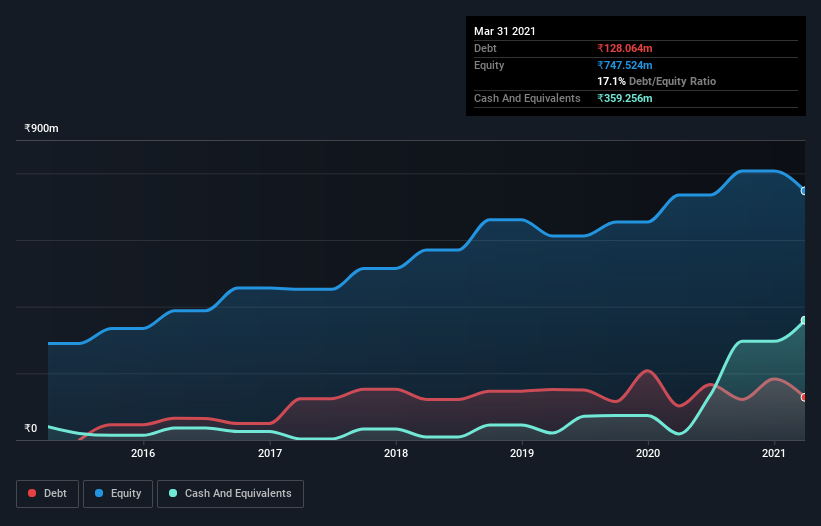Here's Why Cambridge Technology Enterprises (NSE:CTE) Can Manage Its Debt Responsibly
David Iben put it well when he said, 'Volatility is not a risk we care about. What we care about is avoiding the permanent loss of capital.' So it might be obvious that you need to consider debt, when you think about how risky any given stock is, because too much debt can sink a company. As with many other companies Cambridge Technology Enterprises Limited (NSE:CTE) makes use of debt. But the real question is whether this debt is making the company risky.
What Risk Does Debt Bring?
Debt and other liabilities become risky for a business when it cannot easily fulfill those obligations, either with free cash flow or by raising capital at an attractive price. Part and parcel of capitalism is the process of 'creative destruction' where failed businesses are mercilessly liquidated by their bankers. However, a more frequent (but still costly) occurrence is where a company must issue shares at bargain-basement prices, permanently diluting shareholders, just to shore up its balance sheet. Having said that, the most common situation is where a company manages its debt reasonably well - and to its own advantage. The first thing to do when considering how much debt a business uses is to look at its cash and debt together.
View our latest analysis for Cambridge Technology Enterprises
What Is Cambridge Technology Enterprises's Net Debt?
The image below, which you can click on for greater detail, shows that at March 2021 Cambridge Technology Enterprises had debt of ₹128.1m, up from ₹102.3m in one year. But on the other hand it also has ₹359.3m in cash, leading to a ₹231.2m net cash position.

How Healthy Is Cambridge Technology Enterprises' Balance Sheet?
We can see from the most recent balance sheet that Cambridge Technology Enterprises had liabilities of ₹331.5m falling due within a year, and liabilities of ₹67.0m due beyond that. Offsetting this, it had ₹359.3m in cash and ₹326.6m in receivables that were due within 12 months. So it actually has ₹287.3m more liquid assets than total liabilities.
This luscious liquidity implies that Cambridge Technology Enterprises' balance sheet is sturdy like a giant sequoia tree. With this in mind one could posit that its balance sheet means the company is able to handle some adversity. Succinctly put, Cambridge Technology Enterprises boasts net cash, so it's fair to say it does not have a heavy debt load!
Importantly, Cambridge Technology Enterprises's EBIT fell a jaw-dropping 39% in the last twelve months. If that decline continues then paying off debt will be harder than selling foie gras at a vegan convention. The balance sheet is clearly the area to focus on when you are analysing debt. But it is Cambridge Technology Enterprises's earnings that will influence how the balance sheet holds up in the future. So if you're keen to discover more about its earnings, it might be worth checking out this graph of its long term earnings trend.
Finally, a business needs free cash flow to pay off debt; accounting profits just don't cut it. Cambridge Technology Enterprises may have net cash on the balance sheet, but it is still interesting to look at how well the business converts its earnings before interest and tax (EBIT) to free cash flow, because that will influence both its need for, and its capacity to manage debt. Looking at the most recent three years, Cambridge Technology Enterprises recorded free cash flow of 22% of its EBIT, which is weaker than we'd expect. That's not great, when it comes to paying down debt.
Summing up
While we empathize with investors who find debt concerning, you should keep in mind that Cambridge Technology Enterprises has net cash of ₹231.2m, as well as more liquid assets than liabilities. So we don't have any problem with Cambridge Technology Enterprises's use of debt. The balance sheet is clearly the area to focus on when you are analysing debt. But ultimately, every company can contain risks that exist outside of the balance sheet. These risks can be hard to spot. Every company has them, and we've spotted 3 warning signs for Cambridge Technology Enterprises (of which 1 can't be ignored!) you should know about.
If you're interested in investing in businesses that can grow profits without the burden of debt, then check out this free list of growing businesses that have net cash on the balance sheet.
If you’re looking to trade Cambridge Technology Enterprises, open an account with the lowest-cost* platform trusted by professionals, Interactive Brokers. Their clients from over 200 countries and territories trade stocks, options, futures, forex, bonds and funds worldwide from a single integrated account. Promoted
New: AI Stock Screener & Alerts
Our new AI Stock Screener scans the market every day to uncover opportunities.
• Dividend Powerhouses (3%+ Yield)
• Undervalued Small Caps with Insider Buying
• High growth Tech and AI Companies
Or build your own from over 50 metrics.
This article by Simply Wall St is general in nature. It does not constitute a recommendation to buy or sell any stock, and does not take account of your objectives, or your financial situation. We aim to bring you long-term focused analysis driven by fundamental data. Note that our analysis may not factor in the latest price-sensitive company announcements or qualitative material. Simply Wall St has no position in any stocks mentioned.
*Interactive Brokers Rated Lowest Cost Broker by StockBrokers.com Annual Online Review 2020
Have feedback on this article? Concerned about the content? Get in touch with us directly. Alternatively, email editorial-team (at) simplywallst.com.
About NSEI:CTE
Cambridge Technology Enterprises
A business and technology services company, provides IT solutions to enterprise services in India, the United States, the Middle East, and internationally.
Good value with slight risk.
Similar Companies
Market Insights
Community Narratives




